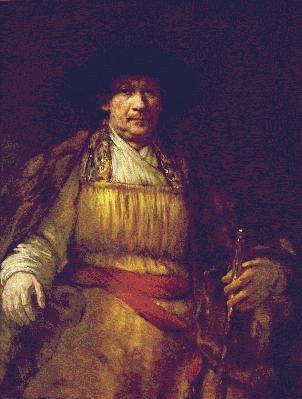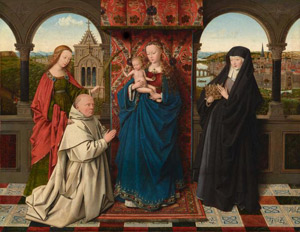From Mansion to Museum
John Haberin New York City
The Frick Collection Heads Upstairs
I have never had a map to the Frick Collection. I never needed one. From the moment I returned to New York after college, it was a place to call home.
It was a place to find myself and to discover art, just as Central Park across the street had served me in growing up as a place to find myself and New York. Not that I shall ever have an actual home like the Frick, a stone mansion with ever so many rooms. Nor should I want one, when the city has so many marvelously adult places to work and to play. But Henry Clay Frick did, and his children could come downstairs in the morning to what has since become a museum for the likes of Rembrandt and Jan Vermeer. Wall paintings transform a room into a Rococo garden in defiance of gravity and Central Park,  with a commanding cast in portraits to chastise me for my frivolity. The collection runs from the early Renaissance to the early twentieth century, with so much more along the way.
with a commanding cast in portraits to chastise me for my frivolity. The collection runs from the early Renaissance to the early twentieth century, with so much more along the way.
Now, though, I had to wonder. At last, the Frick invites visitors upstairs, if not for breakfast, then for a proper café and still more room for art. It has emerged from expansion, remodeling, and recovery with almost a third more exhibition space, a larger auditorium below ground, and other features of a modern museum. I wondered if I might need a map after all, and I should not begrudge you if you do. It is a respectful expansion all the same—respectful enough that one would need to look long and hard to know what has moved and why. It has earned uniform critical praise, but still I felt out of place in the old family rooms upstairs.
Entering history
I am used by now to museum expansions, and museums are all but obliged to have them. The New Museum, once a fancy designation for one-room installations curated by its founder, Marcia Tucker, is letting its stacked boxes tumble south along the Bowery (a work in progress), and the Met will soon revamp its incursion on Central Park for modern and contemporary art. A 2015 home for the Whitney by Renzo Piano still looks like a hospital or a prison, but it works very well indeed. A 2019 expansion almost rescues the Museum of Modern Art from its disaster of an expansion in 2004. Piano reveled in excess again at the Morgan Library in 2016, moving the entrance from J. P. Morgan's actual library to an atrium devoid of art. The Bronx Museum, the Studio Museum in Harlem, and the Princeton University Museum are wrapping up their expansions right now—and, sad to say, I could go on.
But never mind. I have lost that battle long ago. Museum-goers no doubt deserve a place to eat and an education center—the thrust of a Lower East Side building for the International Center of Photography. Even the Morgan puts out children's books and crayons in its atrium. And the expanded Frick Collection looks promising enough from the outside. Little above ground is brand new, and additions adopt the same Indiana limestone as Carrère and Hastings for the mansion in 1914 and John Russell Page for the museum in 1935. The garden looks lusher than ever, and it seems only right that the Frick reopened in April, at the height of spring.
The architects have their priorities, and they are good ones. The same grand old entrance now leads to a larger ticketing area to handle larger crowds, with the restaurant safely upstairs. Better yet, unlike at the Morgan Library, I could then head back from there the old way, to the magnificent indoor fountain and beyond. To be sure, I had better things to see than a fountain. But I had found comfort there many a time after a walk from the subway. Selldorf Architects and Beyer Blinder Belle could have been thinking of me all along.
I stepped next into the same room as in the past, largely for James McNeill Whistler, and then to its right, where traveling exhibitions have often displaced Thomas Gainsborough. There is as yet no sign of them, although "Vermeer's Love Letters" is already on its way. Nor is there is a contemporary artist or two to make history "relevant" to newcomers, although the Frick is not above that museum fashion either. Instead, to Whistler's left, I could walk right into the Frick's largest room and my most precious memories. There a woman sits for her maid bearing a letter—one of three paintings in the collection, all by Jan Vermeer, that place men and women in a larger world of maps, signs, budding empires, and love. Like her, so much of my feelings about art come out of the Frick, along with this Web site, and I shall try not to mention them all.
That room also has a seated self-portrait by Rembrandt, all but enthroned without possessions, apart from rags and an artist's imaginings. It has his Polish Rider, which had me arguing for the value of critics, historians, and attributions in keeping the past alive. As I continued to other rooms, I could encounter again Salisbury Cathedral by John Constable, with his uncanny mix of Romanticism and precision—and Saint Francis by Giovanni Bellini, with sunlight and the stigmata as a single gift of god. Portraits by Titian hang to either side, from an artist old and young. That Rococo playroom and garden, from François Boucher, still lies beyond, crazy as ever. Even I have offered a token defense.
They could serve as a pocket history of Western art, as textbooks once saw it and as new generations renew it. To help, the Frick has preserved its old-fashioned labels rather than tedious wall text—directing visitors directs visitors to their phones and Bloomberg Connects for more. To help, too, renovation has included a "skylight project," like the Met's but with less hoo-hah, for a healthy cleaning to let in the light. Exterior light itself now enters a glass-enclosed corridor surrounding the garden. For the first time I found myself aware of which rooms face Fifth Avenue and the park. I might have found a map.
A larger map
What, then, has changed in all those new square feet (eighty-two thousand of them, should you be keeping track)? You may be tempted to say nothing—and a good thing, too. It would take a remarkable memory anyway to spot the new, beyond a room for drawings. Could two of the three Vermeers have left that one large room, and could anything else has moved with them? That glass-enclosed corridor offers a clue. It now displays porcelain, as does a room just past the long one, with a surprising clarity of color and representation. They signal a renewed effort to integrate the decorative arts, but as art rather than the highly wrought luxury goods of the Eveillard and Moore gifts just months before.
 That second room for porcelain used to hold a standing saint by Piero della Francesca—whose scowl, bearing, and red robe should stop you in your tracks. Beside it hung a painting by Jan van Eyck completed after his death, with the broader strokes of Petrus Christus. van Eyck's sunlight is as intricate as his city, its urban architecture a tale of suffering and release. Both paintings have moved upstairs. While not imposing order on a seemingly untouchable collection, the second floor does now frame the whole with the Renaissance and pre- or Post-Impressionism. Art itself provides the map.
That second room for porcelain used to hold a standing saint by Piero della Francesca—whose scowl, bearing, and red robe should stop you in your tracks. Beside it hung a painting by Jan van Eyck completed after his death, with the broader strokes of Petrus Christus. van Eyck's sunlight is as intricate as his city, its urban architecture a tale of suffering and release. Both paintings have moved upstairs. While not imposing order on a seemingly untouchable collection, the second floor does now frame the whole with the Renaissance and pre- or Post-Impressionism. Art itself provides the map.
Reaching them delivers the most startling change of all. A lavish stairwell, unlike a second just past the ticket counter, was there all along, where a museum visit might once have ended. The mansion is that much more one's own. Is Frick's daughter coming down soon for breakfast? You can judge better when the restaurant opens in summer, but I suspect not. The rooms upstairs have found a purpose in art, but memories of home are thoroughly erased.
It is not the museum I once knew, only not in the way I expected and feared. After the luxuriant architecture of the old museum, the upstairs rooms seem modest and cold. They have a more conventional symmetry, to either side of twin corridors, in cramped quarters with no invitation to the eye between rooms. They have almost no decorative detail, and the corridors are barer still. They can make art look abandoned by mistake—and a visitor an intrusion. Rather than a museum or a mansion, one could be casing out a New York apartment.
Then, again, architecture can change only so much, and art has a visible and palpable presence all its own. It surprised practically everyone that the Frick Collection looked great in its temporary home at the Frick Madison (the Whitney's former home and the former Met Breuer)—but a collection this good would look halfway decent on the subway. Bellini's Saint Francis really could hold a room to itself, and it can hold its place in the mansion now. An expansion is no less needed, and the bareness also signals a proper restraint. Piero, Hans Holbein, Diego Velázquez, and Francisco de Goya can still send you home in fear for your life. Still, this may be only the start of hangings and rehangings yet to come.
Meanwhile, they bring home the greatest change of all. No longer my private museum, the new Frick is downright packed, even on a weekday. And the crowds may find a map right within that great hall and within the art. Jacob van Ruisdael takes care to paint alternate paths through a wooded Dutch landscape, to let you know exactly where you might go. Vermeer's woman with a letter holds a pen with its point on the table and a space below that increases millimeter by millimeter, ending in her hand. Imagined or observed, art knows to take their measure.

The Frick Collection reopened to the public April 17, 2025.




